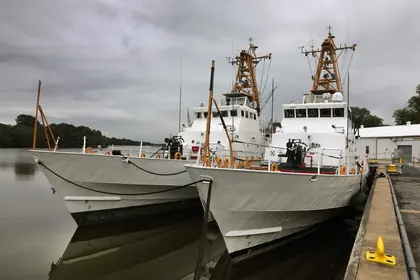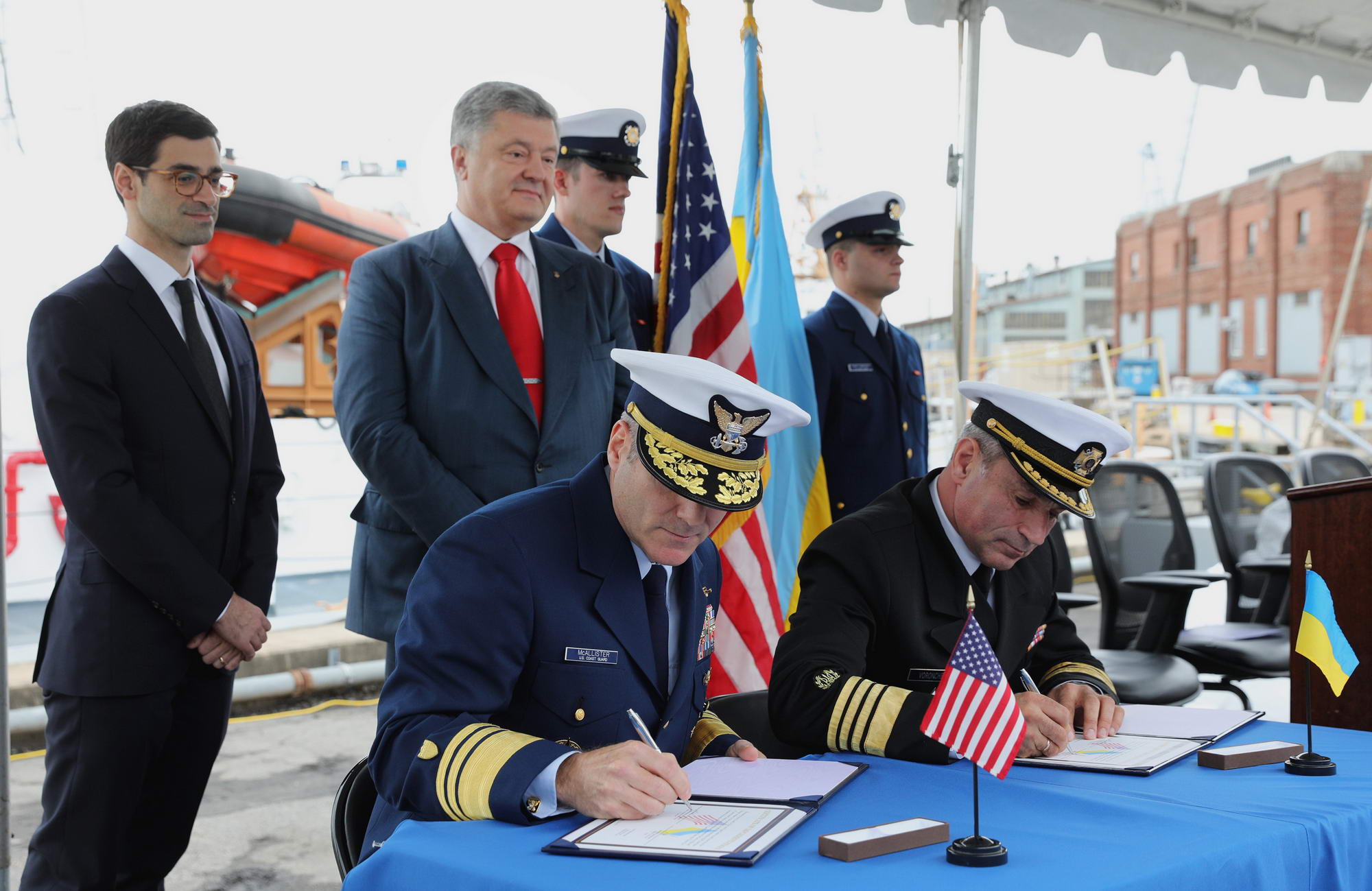After nearly four years of bureaucratic blockading between government agencies, Ukraine finally agreed to take delivery of two U.S. Island-class patrol boats as free military aid from the United States.
During an official ceremony on Sept. 27 in Baltimore, some 50 kilometers northeast of Washington D.C., Ukraine’s top naval commander, Ihor Voronchenko, and U.S. Coast Guard Vice Admiral Michael F. McAllister signed handing-over certificates paving the way for the transporting of the vessels to Ukraine.
“This aid is especially crucial at a time when Russia is undermining the freedom of navigation in the Sea of Azov, cowardly hunting and intimidating commercial ships,” Ukrainian President Petro Porohsenko said in his speech at an event following his address to the 73rd United Nations General Assembly session in New York City on Sept. 26.
“Our task is to convince the Kremlin that we are committed to defending Ukraine’s shores.”
With all papers signed, Ukraine is still expected to invest some $10 million in redeploying the cutters to its shores and making them operational in its Naval Forces.
Also, according to Poroshenko, with over $1 billion of military aid delivered since the outbreak of Russia’s war in Donbas in 2014, the United States remain the word’s leader in providing practical assistance to Ukraine’s Armed Forces.
In his speech, Ukraine’s leader, however, did not mention that the transfer of the U.S. Island-class cutter had been tainted by scandal involving his business interests in Ukraine’s defense production, because of which the deal was allegedly stalled for nearly four years.
The revelation appeared in late March with an investigation by the Radio Liberty/Radio Free Europe’s investigative TV program Schemes. The project’s journalists revealed that the U.S. government have been offering the two crafts to Ukraine as part of its non-paid aid under the Excess Defense Article Program (EDAP) since 2014.
As early as in February 2015, the Ukrainian General Staff of the Armed Forces officially submitted to the U.S. Office of Defense Cooperation a letter of request to receive the mentioned patrol vessels from the United States.
Nonetheless, for months and years after that, the cutters remained moored in the Baltimore port, still waiting for Ukrainian government merely to issue a special decree authorizing the Ministry of Defense to directly approach the United States to effect the transfer, Schemes said.
The program’s host, Natalia Sedletska, added in a March 30 Facebook post that according to conversations with U.S. officials in Washington, the transfer “contradicts the mercenary interests of Ukraine’s leadership.”
According to Schemes, the Island cutters could endanger defense production contracts given to Kuznya Na Rubalskomy, a Kyiv-based shipyard owned by Petro Poroshenko and Ihor Kononenko, his long-time friend, business partner, and first deputy chairman of Poroshenko’s 139-member faction in the Verkhovna Rada.
Poroshenko’s enterprise was the only Ukrainian shipyard still capable of producing small combat boats for the Ukrainian Navy, the journalists claimed. In particular, the Kuznya was contacted to produce 18 Gurza-M armored gunboats through 2020, each one billed to Ukraine’s defense budget at a cool $30 million.
At the same time, accepting the two 168-ton U.S.-produced cutters, built between 1985 and 1992, would cost nearly $10 million for Ukraine, while the market price for each Island boat would be up to $25 million.
Basing on these revelations, the journalists concluded that the transfer was deliberately stalled in order to ensure Poroshenko’s business was not deprived of orders for combat vessels.
While the Presidential Administration declined to comment on the case, saying it was not connected the country’s defense production, the naval command accused Schemes of revealing sensitive information that was “beneficial to the aggressor.”
Following the uproar in media, Poroshenko on April 4 decried the investigation as “fake” and “incorrect,” and vowed that the Island vessels would soon join the Ukrainian Navy after completing “internal state procedures for the completion and approval of the draft contract that we received from the American side.”
Later, on Sept. 26, a day before the ceremony in Baltimore, Presidential Spokesman Svyatoslav Tsegolko, however, unexpectedly announced that Poroshenko would sell the shipyard to a buyer, later identified as Serhiy Tihipko, a former vice prime minister and businessman under ousted former Ukrainian President Viktor Yanukovych.
The Ukrainian government on Sept. 12 eventually approved the signing of an agreement to accept the Island boats, a step that had been reportedly expected by the U.S. government at least since 2015.
Meanwhile, the crisis in the Azov region continues to deteriorate, as Russia boosts its military presence in the region. According to numerous reports, Russia over the past several months has deployed at least 10 warships and up to 40 small patrol boats, a sizable force that includes at least six Shmel-class artillery boats, seven assault landing craft, and two corvettes capable of carrying Kalibr cruise missiles.
Enjoying full control of the Kerch Strait between Russia’s mainland and occupied Crimea, Russia is also interrupting freight traffic in the Azov Sea, causing severe economic loses to the Ukrainian ports of Mariupol and Berdyansk.
According to BBC Ukrainian, the cargo turnover for both parts declined by approximately 10 percent in 2018, with Russia stopping and searching ships sailing to Ukrainian shores, sometimes detaining them for up to several days.
Ukraine, which only has two lightly armed coastguard detachments, is hugely outnumbered and outgunned compared to the Russian military forces in the region.
The past several weeks of the crisis, however, have seen the Ukrainian military start to deploy more of its extremely limited sea power to the sensitive region, to prevent the situation there getting completely out of control.
In September, two armored gunboats were redeployed overland to Berdyansk, and more two newly-built Centaur-class small assault craft were launched in Kyiv. They are to be sent overland to the Azov Sea region. In future, Ukrainian seaborne defenses in the region are to be concentrated at a naval base in Berdyansk, the creation of which the Ukrainian government announced on Sept. 16.
On Sept. 23, two Ukrainian vessels, the search and rescue vessel Donbas and the fleet tug Korets, became the first Ukrainian naval vessels to pass through the Russian-controlled Kerch Strait in the Azov Sea.
As the Ukrainian vessels passed under the illegally built Kerch Bridge, a small flotilla of Russian warships swarmed around them. Russia built the bridge to connect its territory to the Ukrainian territory of Crimea, which is currently under Russian military occupation.
You can also highlight the text and press Ctrl + Enter





